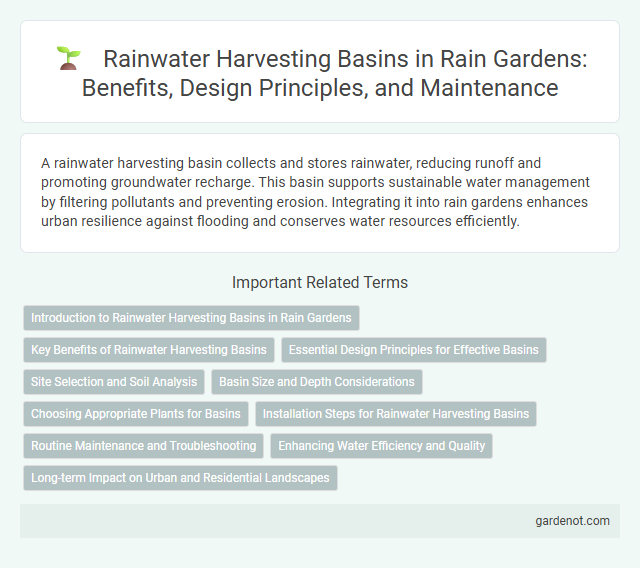A rainwater harvesting basin collects and stores rainwater, reducing runoff and promoting groundwater recharge. This basin supports sustainable water management by filtering pollutants and preventing erosion. Integrating it into rain gardens enhances urban resilience against flooding and conserves water resources efficiently.
Introduction to Rainwater Harvesting Basins in Rain Gardens
Rainwater harvesting basins in rain gardens are engineered depressions designed to collect and temporarily hold stormwater runoff, promoting infiltration and reducing surface runoff. These basins filter pollutants through soil and vegetation, improving water quality while replenishing groundwater supplies. Properly designed basins enhance urban stormwater management by mitigating flooding and supporting sustainable landscape practices.
Key Benefits of Rainwater Harvesting Basins
Rainwater harvesting basins effectively capture and store runoff, reducing stormwater runoff and mitigating urban flooding risks. They enhance groundwater recharge by allowing water to infiltrate the soil, promoting aquifer replenishment and supporting local ecosystems. These basins also improve water quality by filtering pollutants and sediment, contributing to healthier waterways and sustainable water management.
Essential Design Principles for Effective Basins
A rainwater harvesting basin must incorporate proper grading to ensure efficient water capture and prevent erosion. Integrating a durable liner and adequate soil permeability supports optimal infiltration while minimizing contamination risks. Vegetation selection and strategic placement further enhance water absorption and filtration, promoting sustainable stormwater management.
Site Selection and Soil Analysis
Selecting a rainwater harvesting basin site requires evaluating topography to ensure proper water flow and avoid flooding, favoring areas with gentle slopes and natural depressions. Soil analysis is crucial to determine permeability and infiltration rates, with sandy loam or loamy soils preferred for efficient water absorption and minimizing surface runoff. Testing soil pH, texture, and organic content helps optimize rain garden performance by enhancing water retention and supporting plant health.
Basin Size and Depth Considerations
Rainwater harvesting basins require careful consideration of size and depth to optimize water retention and infiltration rates. The basin size should correspond to the catchment area, typically designed to capture the runoff from 1 to 1.5 inches of rainfall, while the depth ranges from 6 to 18 inches to balance storage capacity and prevent waterlogging. Properly sized and deep basins enhance filtration, support plant health, and reduce surface runoff effectively in rain garden systems.
Choosing Appropriate Plants for Basins
Selecting appropriate plants for rainwater harvesting basins is crucial for optimizing water absorption and filtration. Native species with deep root systems, such as switchgrass (Panicum virgatum) and blue flag iris (Iris versicolor), enhance soil permeability and reduce runoff. Incorporating a mix of perennials and grasses adapted to both wet and dry conditions ensures basin resilience and maximizes pollutant removal.
Installation Steps for Rainwater Harvesting Basins
Excavation forms the foundation of rainwater harvesting basin installation, ensuring proper depth and slope for optimal water flow and infiltration. A layered structure follows, typically consisting of gravel and sand to facilitate filtration, topped by soil suited for native vegetation that enhances water absorption and prevents erosion. Installation concludes with strategic planting and the placement of inlet and outlet structures, allowing controlled water capture and overflow management to maximize rainwater retention and reduce runoff.
Routine Maintenance and Troubleshooting
Routine maintenance of rainwater harvesting basins includes regular inspection and removal of debris to prevent clogging and ensure efficient water infiltration. Checking for signs of erosion, sediment buildup, and vegetation health supports optimal basin performance and longevity. Troubleshooting common issues involves addressing poor drainage by amending soil texture or adjusting basin grading to promote proper water flow and absorption.
Enhancing Water Efficiency and Quality
Rainwater harvesting basins are designed to capture and store runoff, reducing reliance on municipal water sources and promoting sustainable water management. These basins enhance water quality by filtering pollutants and sediments through soil and vegetation before infiltration or reuse. Integrating rainwater harvesting basins in urban landscapes supports groundwater recharge and mitigates stormwater pollution effectively.
Long-term Impact on Urban and Residential Landscapes
Rainwater harvesting basins in rain gardens significantly reduce urban runoff, improving groundwater recharge and decreasing flood risks. These basins enhance soil quality and biodiversity by supporting native vegetation, contributing to sustainable urban ecosystems. Over time, they help mitigate urban heat islands and promote resilient, water-efficient residential landscapes.
Rainwater harvesting basin Infographic

 gardenot.com
gardenot.com